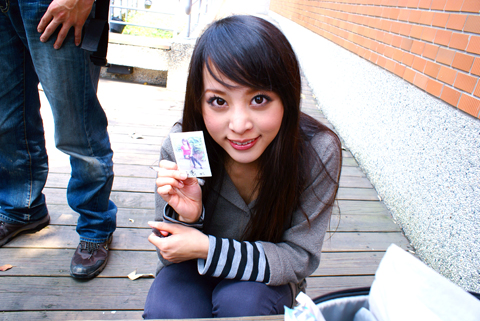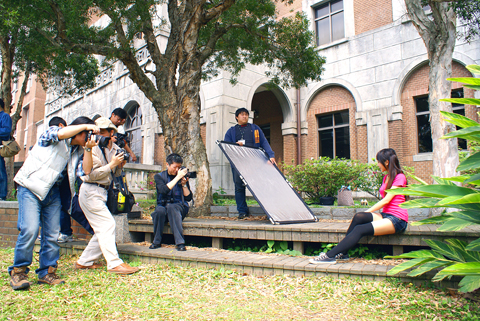Flora knows she wants to be a model. And she has achieved her goal.
Well, kind of.
Rather than appearing on the cover of a fashion magazine, her pictures appear on the blogs of many amateur photographers.

Flora is a waipai (outside photography, 外拍) model for the Web site i-photo, which links amateur photographers with aspiring models for photo shoots at scenic areas throughout Taiwan. The 23-year-old student of aquaculture at National Taiwan Ocean University has been modeling with i-photo (also called lovephoto, www.i-photo.com.tw) for two years and dreams of turning professional.
"I can earn more in three hours doing this job than I could modeling for a magazine, newspaper or television," says Flora, whose family and boyfriend both support her decision to become a waipai model.
"Besides, it's far less stressful."

PHOTO: Noah Buchan, Taipei Times
Many would-be models sign up with waipai Web sites to earn extra cash, get free, professional-quality portraits for their modeling portfolios, and work on what they hope turns from a weekend gig into a professional career.
Mia Teng (鄧婷), is a talent scout at Unique Image (絕色光影, www.uniqueimage.com.tw), a modeling agency that operates waipai (外拍) activities throughout Taipei.
She says there are two kinds of waipai. The more common "fashion photography" (時裝) sees models dressed in everyday attire; the second, called "sexy photography" (性感), features models stripping down to the bare minimum.

PHOTO: NOAH BUCHAN, TAIPEI TIMES
"Of course one model's everyday fashion might be wearing practically nothing at all. So these distinctions are largely irrelevant," she says.
Teng spends her weekends chaperoning models at some of the agency's six monthly photo shoots in Taipei. The rest of the week finds the diminutive former Unique model scouring the Internet for photo albums of attractive young women who she then contacts with job offers.
"These girls love taking pictures of themselves or having others take pictures of them. With the proliferation of online photo albums and blogs, it's easy to find attractive … young girls willing to work weekends for extra money," she says.
That was how Teng found Doris. The 166cm-tall Chinese literature student at National Taiwan University (NTU) is at the university's front gates today - but she's not here for class. Dressed in hot-pink tights, pumps and a singlet, she strikes poses in front of a fountain. (Models interviewed for this story are referred to by English-language names to protect their privacy.)
The blog where Teng found Doris gets on average 1,000 hits per day, which is normal for an amateur model with her looks.
According to Teng, a model at Unique starts off earning NT$3,500 for a three-hour shoot and can make a maximum of NT$4,500, depending on her popularity. With Taiwan's minimum wage being NT$90 per hour or NT$15,840 per month, it's easy to imagine why many young women want to work for these companies. Most of the models are university students, but some are still in high school.
For those who hope to become professionals, waipai is good practice. And waipai allows them to avoid paying for costly studio portraits for their modeling portfolios, which can cost upwards of NT$30,000.
While waipai models can access the pictures taken by their waipai photographers, post them on their blogs and use them for their portfolios, waipai photographers are forbidden to sell their images - though they are free to post them on their own blogs.
Teng can tell almost immediately if a girl has potential. "Ultimately, though, the photographers decide if we have made the right choice," she says.
Tim Lai (賴政廷), co-founder of i-photo, agrees. He estimates his Web site organizes 50 waipai activities per month in Taiwan's larger cities.
"There is no formula to determine which models will be popular," he says on a balmy Saturday morning at the main gate of National Taiwan University. "That's why we audition every model twice before placing them on our Web site."
As Lai banters with some of the roughly 70 waipai photographers (who paid NT$600 to NT$800 for a three-hour activity), models wander over and check in with i-photo representatives. "Around 30 models will show up today," he says. "But only 10 are working; the rest are auditioning to become [paid i-photo] models."
Zoey (小呀) is one of the latter. Here for her second audition, the 24-year-old student of Recreation and Sport Management at National Taipei University dresses in denim shorts, long white boots and a low-cut purple top. When asked how she chooses her clothing, Zoey says that it depends on how she feels.
"If I'm feeling sexy, I'll wear sexy clothing," she says.
A few weeks after the audition, Zoey's picture appeared on the i-photo Web site. By the end of the week, six photographers had signed on for a photo shoot with her - enough for the waipai activity to go.
According to Lai and Teng, models are responsible for choosing their own wardrobe, which should contain three changes of clothes.
Flora says i-photo pays the best (close to NT$5,000 when traveling expenses are included), is the best at giving her consistent work, and is the safest - a primary concern for all models. Flora's most frightening experience with photographers was when one demanded that she remove her coat. "He didn't say remove my clothing, just my coat," adding, "No matter what industry you work in there are good and bad people," she said. "So I'm not concerned."
Not all waipai models are so lucky.
In one extreme case, two people allegedly lured a young woman to a motel and coerced her to strip for photographers, according to a report in the Liberty Times (the Taipei Times' sister newspaper).
Several models have removed their photo blogs from the Internet after receiving threatening messages or rude comments. One model wrote on her blog that she received too many messages from people wanting one-night stands. Another, famous among bloggers for her bust size, removed the "leave message" option from her blog because people were posting comments claiming she has fake breasts.
Still, if the anonymity of the Internet creates an environment for lurid or harassing comments, the four models interviewed for this story all say they feel safe around waipai photographers.
"My parents and my boyfriend have seen the pictures and they support me," Flora says.
Doris also shows the pictures to her parents and refuses "to be photographed wearing a bathing suit."
Flora says if she hasn't landed a professional modeling contract by the age of 28, she'll find another job. In the meantime, she has become a fixture on Lai's Web site, often doing three photo shoots in one weekend.
"It's just a way to earn money right now while moving towards the career I want," she says.

The Democratic Progressive Party (DPP), Chinese Nationalist Party (KMT), and the country’s other political groups dare not offend religious groups, says Chen Lih-ming (陳立民), founder of the Taiwan Anti-Religion Alliance (台灣反宗教者聯盟). “It’s the same in other democracies, of course, but because political struggles in Taiwan are extraordinarily fierce, you’ll see candidates visiting several temples each day ahead of elections. That adds impetus to religion here,” says the retired college lecturer. In Japan’s most recent election, the Liberal Democratic Party lost many votes because of its ties to the Unification Church (“the Moonies”). Chen contrasts the progress made by anti-religion movements in

Taiwan doesn’t have a lot of railways, but its network has plenty of history. The government-owned entity that last year became the Taiwan Railway Corp (TRC) has been operating trains since 1891. During the 1895-1945 period of Japanese rule, the colonial government made huge investments in rail infrastructure. The northern port city of Keelung was connected to Kaohsiung in the south. New lines appeared in Pingtung, Yilan and the Hualien-Taitung region. Railway enthusiasts exploring Taiwan will find plenty to amuse themselves. Taipei will soon gain its second rail-themed museum. Elsewhere there’s a number of endearing branch lines and rolling-stock collections, some

Last week the State Department made several small changes to its Web information on Taiwan. First, it removed a statement saying that the US “does not support Taiwan independence.” The current statement now reads: “We oppose any unilateral changes to the status quo from either side. We expect cross-strait differences to be resolved by peaceful means, free from coercion, in a manner acceptable to the people on both sides of the Strait.” In 2022 the administration of Joe Biden also removed that verbiage, but after a month of pressure from the People’s Republic of China (PRC), reinstated it. The American

This was not supposed to be an election year. The local media is billing it as the “2025 great recall era” (2025大罷免時代) or the “2025 great recall wave” (2025大罷免潮), with many now just shortening it to “great recall.” As of this writing the number of campaigns that have submitted the requisite one percent of eligible voters signatures in legislative districts is 51 — 35 targeting Chinese Nationalist Party (KMT) caucus lawmakers and 16 targeting Democratic Progressive Party (DPP) lawmakers. The pan-green side has more as they started earlier. Many recall campaigns are billing themselves as “Winter Bluebirds” after the “Bluebird Action”